steering ACURA MDX 2022 Owners Manual
[x] Cancel search | Manufacturer: ACURA, Model Year: 2022, Model line: MDX, Model: ACURA MDX 2022Pages: 712, PDF Size: 22.65 MB
Page 6 of 712

Contents
Child Safety P. 63Exhaust Gas Hazard P. 80Safety Labels P. 81
Tailgate P. 147 Security System P. 157
Operating the Switches Around the Steering Wheel P. 166 Mirrors P. 187
Interior Convenience Items P. 208 Climate Control System P. 229
Audio Error Messages P. 318General Information on the Audio System P. 322
Bluetooth ® HandsFreeLink ® P. 376 AcuraLink ® P. 405
Off-Highway Driving Guidelines P. 432 When Driving P. 434 AcuraWatchTM P. 474 Braking P. 551
Surround View Camera System* P. 573 Refueling P. 581
Maintenance Under the Hood P. 595 Replacing Light Bulbs P. 608
Checking and Maintaining Tires P. 615 Battery P. 624 Remote Transmitter Care P. 626
Accessories and Modifications P. 634
Handling of the Jack P. 661 Engine Does Not Start P. 662 If the Battery Is Dead P. 666
Emergency Towing P. 685 If You Cannot Unlock the Fuel Fill Door P. 686
Devices that Emit Radio Waves P. 693 Reporting Safety Defects P. 694
Authorized Manuals P. 700 Client Service Information P. 701
Quick Reference GuideP. 6
Safe DrivingP. 31
Instrument PanelP. 83
ControlsP. 127
FeaturesP. 237
DrivingP. 415
MaintenanceP. 585
Handling the UnexpectedP. 637
InformationP. 689
IndexP. 702
22 ACURA MDX-31TYA6000_02.book 5 ページ 2020年11月5日 木曜日 午前11時39分
Page 7 of 712
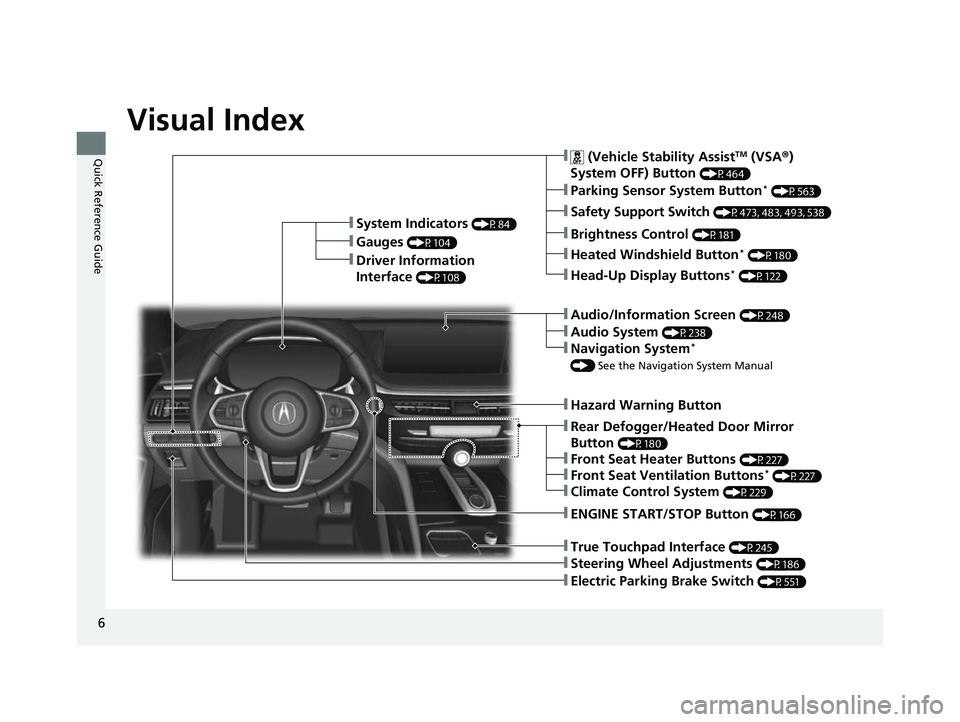
6
Quick Reference Guide
Quick Reference Guide
Visual Index
❚Steering Wheel Adjustments (P186)
❚ENGINE START/STOP Button (P166)
❚Audio System (P238)
❚System Indicators (P84)
❚Gauges (P104)
❚Driver Information
Interface
(P108)
❚ (Vehicle Stability AssistTM (VSA®)
System OFF) Button
(P464)
❚Parking Sensor System Button* (P563)
❚Safety Support Switch (P473, 483, 493, 538)
❚Brightness Control (P181)
❚Heated Windshield Button* (P180)
❚Hazard Warning Button
❚Rear Defogger/Heated Door Mirror
Button
(P180)
❚Front Seat Heater Buttons (P227)
❚Front Seat Ventilation Buttons* (P227)
❚Climate Control System (P229)
❚True Touchpad Interface (P245)
❚Head-Up Display Buttons* (P122)
❚Audio/Information Screen (P248)
❚Navigation System*
() See the Navigation System Manual
❚Electric Parking Brake Switch (P551)
22 ACURA MDX-31TYA6000_02.book 6 ページ 2020年11月5日 木曜日 午前11時39分
Page 8 of 712
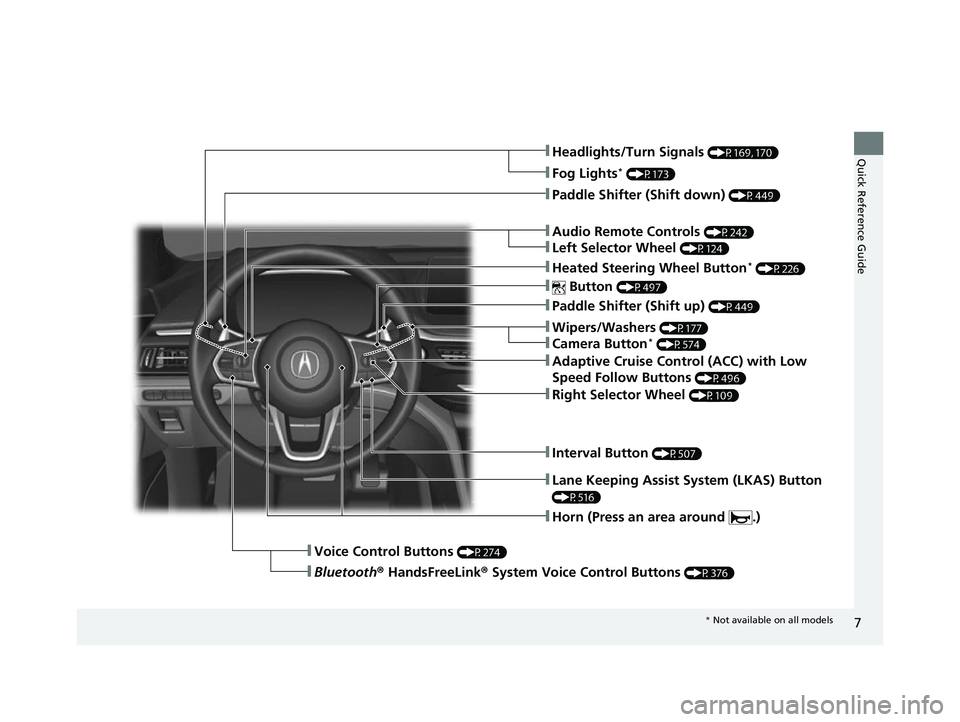
7
Quick Reference Guide
❚Paddle Shifter (Shift down) (P449)
❚Paddle Shifter (Shift up) (P449)
❚Voice Control Buttons (P274)
❚Bluetooth® HandsFreeLink ® System Voice Control Buttons (P376)
❚Heated Steering Wheel Button* (P226)
❚Headlights/Turn Signals (P169, 170)
❚Fog Lights* (P173)
❚ Button (P497)
❚Adaptive Cruise Control (ACC) with Low
Speed Follow Buttons
(P496)
❚Right Selector Wheel (P109)
❚Lane Keeping Assist System (LKAS) Button
(P516)
❚Horn (Press an area around .)
❚Interval Button (P507)
❚Wipers/Washers (P177)
❚Camera Button* (P574)
❚Audio Remote Controls (P242)
❚Left Selector Wheel (P124)
* Not available on all models
22 ACURA MDX-31TYA6000_02.book 7 ページ 2020年11月5日 木曜日 午前11時39分
Page 13 of 712
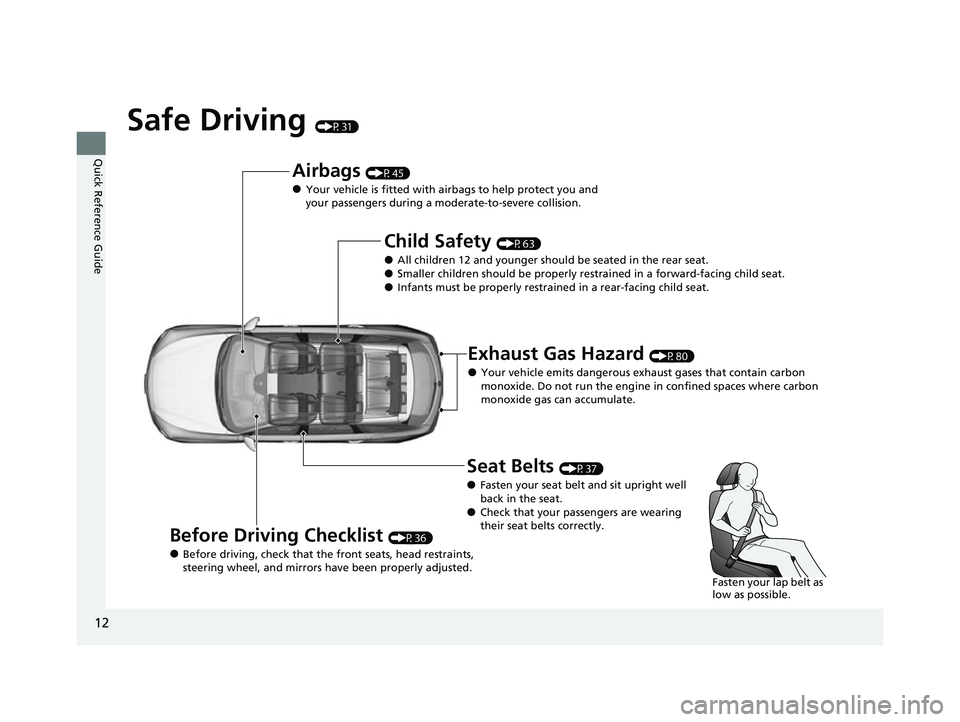
12
Quick Reference Guide
Safe Driving (P31)
Airbags (P45)
●Your vehicle is fitted with airbags to help protect you and
your passengers during a moderate-to-severe collision.
Child Safety (P63)
●All children 12 and younger should be seated in the rear seat.●Smaller children should be properly restra ined in a forward-facing child seat.●Infants must be properly restrained in a rear-facing child seat.
Exhaust Gas Hazard (P80)
●Your vehicle emits dangerous exhaust gases that contain carbon
monoxide. Do not run the engine in confined spaces where carbon
monoxide gas can accumulate.
Before Driving Checklist (P36)
●Before driving, check that the front seats, head restraints,
steering wheel, and mirrors have been properly adjusted.
Seat Belts (P37)
●Fasten your seat belt and sit upright well
back in the seat.
●Check that your passengers are wearing
their seat belts correctly.
Fasten your lap belt as
low as possible.
22 ACURA MDX-31TYA6000_02.book 12 ページ 2020年11月5日 木曜日 午前11時39分
Page 16 of 712
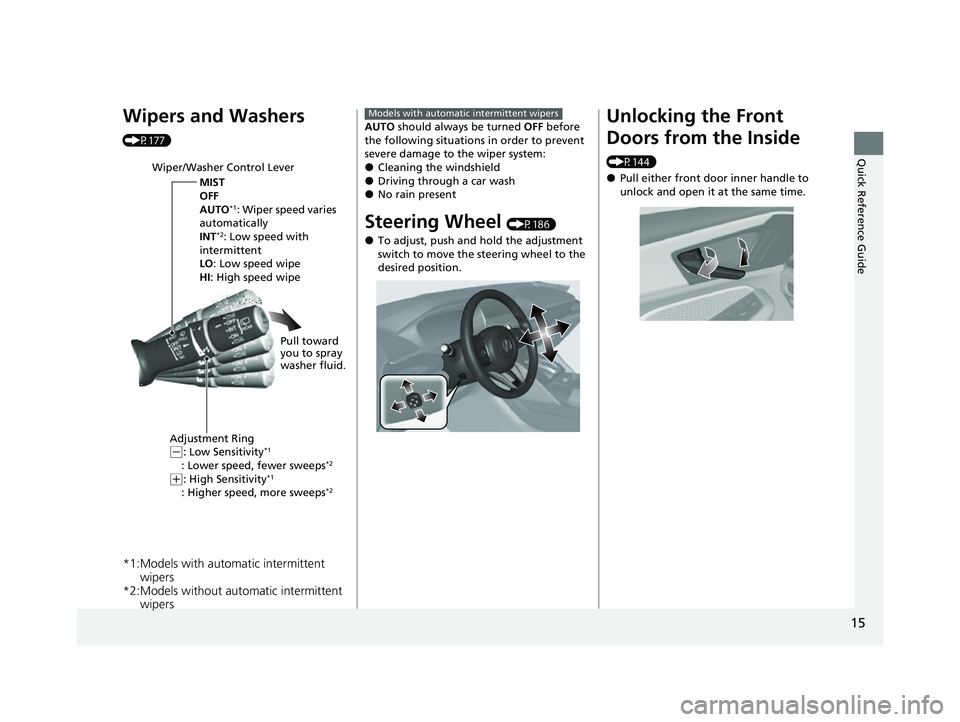
15
Quick Reference Guide
Wipers and Washers
(P177)
*1:Models with automatic intermittent wipers
*2:Models without automatic intermittent
wipers
Wiper/Washer Control Lever
MIST
OFF
AUTO
*1: Wiper speed varies
automatically
INT
*2: Low speed with
intermittent
LO : Low speed wipe
HI: High speed wipe
Pull toward
you to spray
washer fluid.
Adjustment Ring
(-: Low Sensitivity*1
: Lower speed, fewer sweeps*2
(+: High Sensitivity*1
: Higher speed, more sweeps*2
AUTO should always be turned OFF before
the following situations in order to prevent
severe damage to the wiper system:
●Cleaning the windshield●Driving through a car wash●No rain present
Steering Wheel (P186)
●To adjust, push and hold the adjustment
switch to move the steering wheel to the
desired position.
Models with automatic intermittent wipersUnlocking the Front
Doors from the Inside
(P144)
●Pull either front door inner handle to
unlock and open it at the same time.
22 ACURA MDX-31TYA6000_02.book 15 ページ 2020年11月5日 木曜日 午前11時39分
Page 26 of 712

25
Quick Reference Guide
Adaptive Cruise Control
(ACC) with Low Speed
Follow
(P496)
Helps maintain a constant vehicle speed and
a set following-interval behind a vehicle
detected ahead of yours and, if the detected
vehicle comes to a stop, can decelerate and
stop your vehicle, without you having to
keep your foot on the brake or the
accelerator.
Lane Keeping Assist
System (LKAS)
(P514)
Provides steering input to help keep the
vehicle in the middle of a detected lane and
provides tactile and visual alerts if the
vehicle is detected drifting out of its lane.
Road Departure
Mitigation System
(P535)
Alerts and helps to assist you when the
system detects a possibility of your vehicle
unintentionally crossing over detected lane
markings and/or leaving the roadway
altogether.
Traffic Jam Assist (P 523)
The traffic jam assist system uses a radar
sensor mounted behind the emblem and a
camera mounted to the interior side of the
windshield, behind the rearview mirror to
detect and monitor left and right white
(yellow) traffic lane lines as well as any
vehicle ahead. Based on inputs from the
radar sensor and camera, the system adjusts
the speed of your vehicle to maintain a set
interval between your vehicle and the one
detected ahead. It also applies steering
torque to keep your vehicle in the center of
the detected lane when you are driving in
heavy traffic.
Traffic Sign Recognition
System
(P 541)
Reminds you of road sign information, such
as the current speed limit, your vehicle has
just passed through, showing it on the
driver information interface and the head-
up display
*.
* Not available on all models
22 ACURA MDX-31TYA6000_02.book 25 ページ 2020年11月5日 木曜日 午前11時39分
Page 36 of 712

35
uuFor Safe Driving uYour Vehicle’s Safety Features
Safe Driving
Your Vehicle’s Safety Features
The following checklist will help you take an active role in protecting yourself and
your passengers.
1Your Vehicle’s Safety Features
Your vehicle is equipped wi th many features that
work together to help protect you and your
passengers during a crash.
Some features do not require any action on your part.
These include a strong steel framework that forms a
safety cage around the passenger compartment,
front and rear crush zone s, a collapsible steering
column, and tensioners th at tighten the front and
second row outer seat belts in a sufficient crash.
However, you and your passe ngers cannot take full
advantage of these features unless you remain seated
in the correct position and always wear your seat
belts. In fact, some safety features can contribute to
injuries if they are not used properly.
678910
12
Safety Cage
Crush Zones
Seats and Seat-Backs
Head Restraints
Collapsible Steering Column
Seat Belts
Front Airbags
Side Curtain Airbags
Door Locks Side Airbags
11
Seat Belt Tensioners
Knee Airbags
10106
11
7
8
12
11
12
9789
22 ACURA MDX-31TYA6000_02.book 35 ページ 2020年11月5日 木曜日 午前11時39分
Page 47 of 712
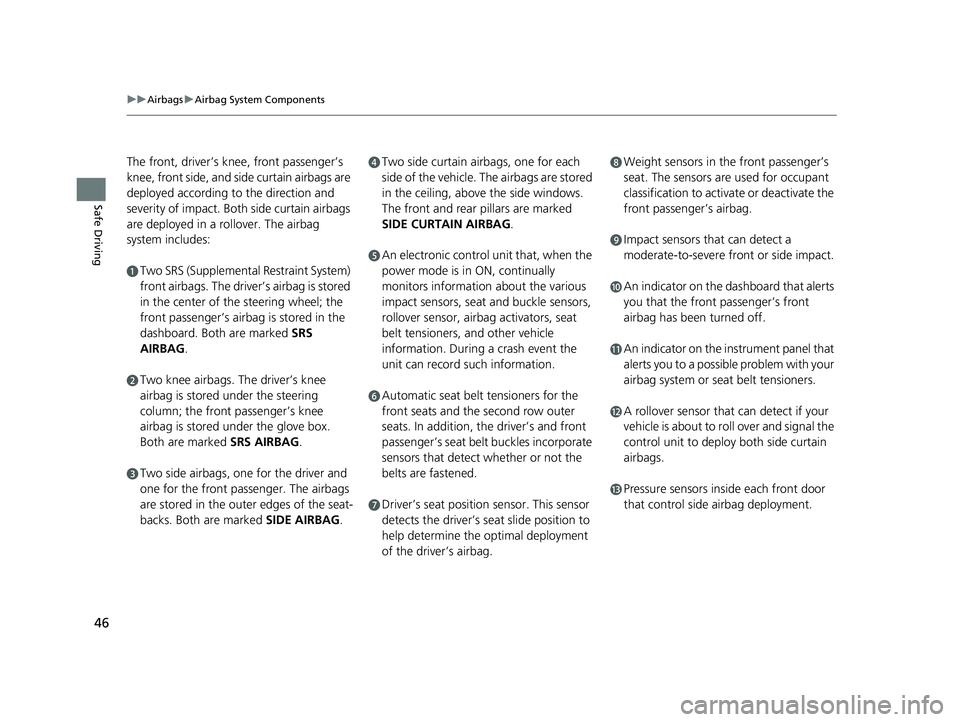
46
uuAirbags uAirbag System Components
Safe Driving
The front, driver’s knee, front passenger’s
knee, front side, and si de curtain airbags are
deployed according to the direction and
severity of impact. Both side curtain airbags
are deployed in a ro llover. The airbag
system includes:
aTwo SRS (Supplemental Restraint System)
front airbags. The driver’s airbag is stored
in the center of the steering wheel; the
front passenger’s airbag is stored in the
dashboard. Both are marked SRS
AIRBAG.
bTwo knee airbags. Th e driver’s knee
airbag is stored under the steering
column; the front passenger’s knee
airbag is stored under the glove box.
Both are marked SRS AIRBAG.
cTwo side airbags, one for the driver and
one for the front passenger. The airbags
are stored in the outer edges of the seat-
backs. Both are marked SIDE AIRBAG .
dTwo side curtain airbags, one for each
side of the vehicle. The airbags are stored
in the ceiling, above the side windows.
The front and rear pillars are marked
SIDE CURTAIN AIRBAG.
eAn electronic control unit that, when the
power mode is in ON, continually
monitors information about the various
impact sensors, seat and buckle sensors,
rollover sensor, airbag activators, seat
belt tensioners, and other vehicle
information. During a crash event the
unit can record such information.
fAutomatic seat belt tensioners for the
front seats and the second row outer
seats. In addition, the driver’s and front
passenger’s seat belt buckles incorporate
sensors that detect whether or not the
belts are fastened.
gDriver’s seat position sensor. This sensor
detects the driver’s seat slide position to
help determine the optimal deployment
of the driver’s airbag.
hWeight sensors in the front passenger’s
seat. The sensors are used for occupant
classification to activa te or deactivate the
front passenger’s airbag.
iImpact sensors that can detect a
moderate-to-severe front or side impact.
jAn indicator on the dashboard that alerts
you that the front passenger’s front
airbag has been turned off.
kAn indicator on the instrument panel that
alerts you to a possib le problem with your
airbag system or seat belt tensioners.
lA rollover sensor that can detect if your
vehicle is about to roll over and signal the
control unit to deploy both side curtain
airbags.
mPressure sensors inside each front door
that control side airbag deployment.
22 ACURA MDX-31TYA6000_02.book 46 ページ 2020年11月5日 木曜日 午前11時39分
Page 48 of 712

47
uuAirbags uAirbag System Components
Safe DrivingAirbags can pose serious hazards. To do their job, airbags must inflate with
tremendous force. So, while airbags help sa ve lives, they can cause burns, bruises,
and other minor injuries, sometimes even fatal ones if occupants are not wearing
their seat belts properl y and sitting correctly.
What you should do: Always wear your seat belt properly, and sit upright and as
far back from the steering wheel as possi ble while allowing full control of the
vehicle. A front passenger should move their seat as far back from the dashboard as
possible.
Remember, however, that no safety system ca n prevent all injuries or deaths that
can occur in a severe crash, even when s eat belts are properly worn and the airbags
deploy.
Do not place hard or sharp objects between yourself and a front airbag.
Carrying hard or sharp objects on your lap, or driving with a pipe or other sharp
object in your mouth, can result in in juries if your front airbag inflates.
Do not attach or place objects on the front, driver’s knee and front
passenger’s knee airbag covers. Objects on the covers marked SRS AIRBAG
could interfere with the proper operation of the airbags or be propelled inside the
vehicle and hurt someone if the airbags inflate.
■Important Facts About Your Airbags1 Important Facts About Your Airbags
Do not attempt to deactivate your airbags. Together,
airbags and seat belts pr ovide the best protection.
When driving, keep hands and arms out of the
deployment path of the fro nt airbag by holding each
side of the steering wheel. Do not cross an arm over
the airbag cover.
22 ACURA MDX-31TYA6000_02.book 47 ページ 2020年11月5日 木曜日 午前11時39分
Page 49 of 712

48
uuAirbags uTypes of Airbags
Safe Driving
Types of Airbags
Your vehicle is equipped with four types of airbags:
• Front airbags: Airbags in front of the driver’s and front passenger’s seats.
• Knee airbags: Airbags under the steering column and under the glove box.
• Side airbags: Airbags in the driver’s and front passenger’s seat-backs.
• Side curtain airbags: Airbags above the side windows.
Each is discussed in the following pages.
Front Airbags (SRS)
The front SRS airbags inflate in a moderate-to -severe frontal collision to help protect
the head and chest of the driver and/or front passenger.
SRS (Supplemental Restraint System) indicates that the airbags are designed to
supplement seat belts, not replace them. Seat belts are the occupant’s primary
restraint system.
The front airbags are housed in the center of the steering wheel for the driver, and
in the dashboard for the front pass enger. Both airbags are marked SRS AIRBAG.
■Housing Locations
1Types of Airbags
The airbags can inflate whenever the power mode is
in ON.
After an airbag inflates in a crash, you may see a
small amount of smoke. This is from the combustion
process of the infl ator material and is not harmful.
People with respiratory pr oblems may experience
some temporary discomfort. If this occurs, get out of
the vehicle as soon as it is safe to do so.
1 Front Airbags (SRS)
During a frontal crash severe enough to cause one or
both front airbags to deploy, the airbags can inflate
at different rates, dependi ng on the severity of the
crash, whether or not the se at belts are latched, and/
or other factors. Frontal airbags are designed to
supplement the seat belts to help reduce the
likelihood of head and chest injuries in frontal
crashes.
22 ACURA MDX-31TYA6000_02.book 48 ページ 2020年11月5日 木曜日 午前11時39分